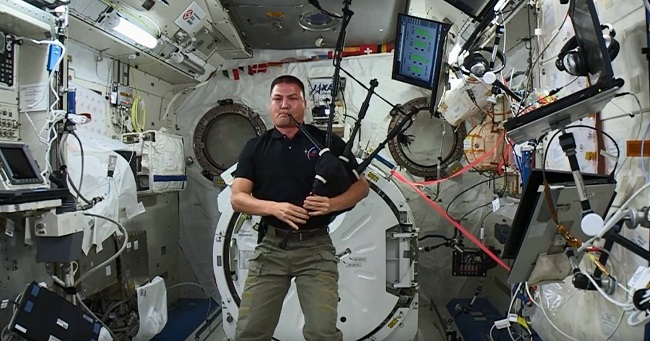McCallum Bagpipes out of this world in space tribute
Six years after astronaut finalist and 1993 Inverness Gold Medallist Bruce Woodley first posed the idea, a set of McCallum pipes were played in the International Space Station when astronaut Kjell Lindgren played “Amazing Grace” in tribute to the late research scientist Victor Hurst.
According to Kenny MacLeod of McCallum Bagpipes, Lindgren contacted him about the idea more than two years ago, wondering if playing the instrument in orbit might be possible
MacLeod said that the pipes are a production P0 set made from acetyl Delrin, which the company routinely makes. Because of payload weight restrictions, keeping weight down is paramount. The pipes had to go through rigourous NASA testing before they went up.

“They are light and can fold away quite small without damaging them, which is what he needed,” MacLeod said. “They were just for the mission and it was just bad timing that their colleague died, but he was taking them anyway.”
MacLeod wasn’t sure if Lindgren started playing specifically for the mission.
The idea of playing pipes in space was proposed by Woodley, who said in 2009, “I think it would be great fun to play bagpipes in space, however it might be a challenge to get a set of bagpipes ‘space certified’ from the point of view of flammability. Also launch costs are high (some estimate north of $25,000/kg) to the space station, thus weight might also need to be reduced to be practical for this purpose. The space station [is] pressurized to 14.7 psi (standard sea level pressure), but the shuttle also has the capability to operate at a reduced pressure (about 10.5 psi, I think) for reasons related to spacewalks. 10.5 psi is equivalent to about 9,000 feet above sea level – think about trying to get a good sound 1,000 feet higher than Vail, Colorado. I believe the Apollo spacecraft were all about 4 psi cabin pressure, or about 32,000 feet above sea level (in 100 per cent oxygen environment) presumably to save spaceship structural weight. I’m guessing if the future lunar spacecraft follow this design, it would be very difficult to play bagpipes and have them sound like anything we hear on the ground without a whole lot of re-design and testing!”
Woodley ultimately was not selected for the program in 2009, and resumed his career as a professor of physics.
Kenny MacLeod added that the pipes might not get back to earth due to further weight restrictions for return flights to Earth. “They might just put them into orbit. That could be interesting if they were found in a few hundred years’ time!”
The pipes were played on the 45th expedition to the International Space Station.

This set of pipes belong in the Air & Space Smithsonian Museum on the Capital Mall along side of the X-1 and the Spirit of Saint Louis. They have to come back. Is anyone aware of any other musical instrument(s) played in outer space?
Kent “Doc” Argubright